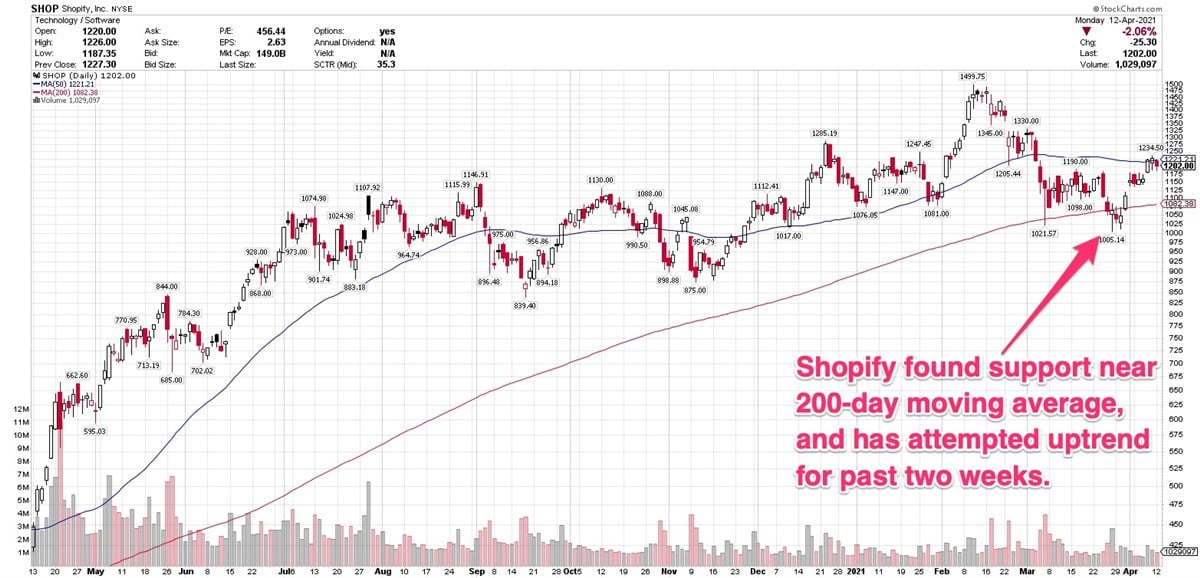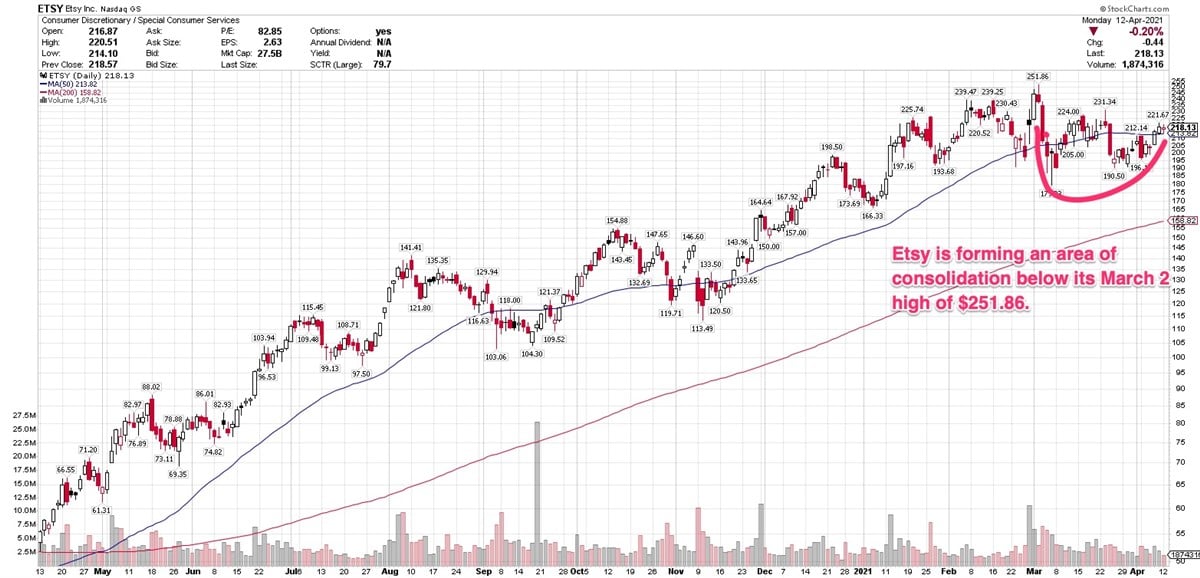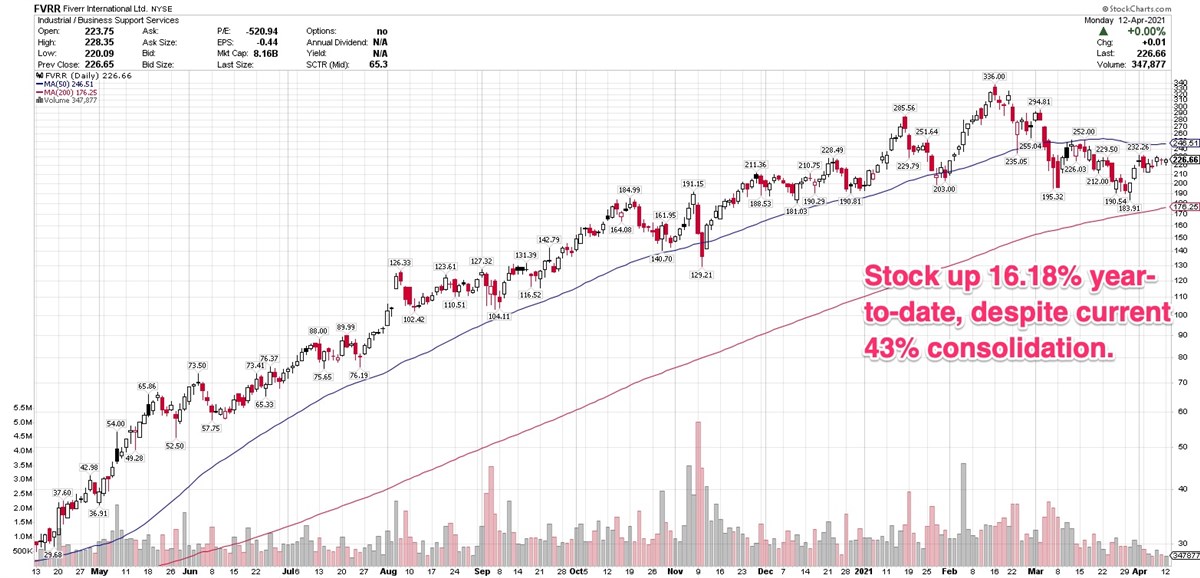By now, we’re all familiar with the theme of pandemic lockdowns boosting business among digital sales platforms, such as
Shopify (NYSE: SHOP),
Etsy NASDAQ: ETSY and
Fiverr NYSE: FVRR.
Not only were people shopping more from home, as retailers closed down or limited their capacity, especially early in the pandemic, but brick-and-mortar businesses shifted their sales online.
All three stocks posted monster price gains in 2020, as well as strong sales and earnings growth. Are these performance levels sustainable?
Shopify is an e-commerce platform that allows retailers to sell online. Users can set up their e-commerce site with their own branding. Shopify charges a subscription fee for its service, with fees starting at $29 per month.
The stock has been correcting since mid-February. It found support near its 200-day moving average, and has been attempting an uptrend for the past two weeks. Shares closed Monday at $1202, down $25.30 or 2.05%.
The current consolidation meant hitting “pause” on Shopify’s rally. The stock is up just 8.42% year-to-date, but 193.80% over the past 12 months.
Downside trading volume was heavy in March as the stock pulled back, but the selling has been muted so far in April.
The company reports first-quarter results on April 28. Analysts peg earnings at $0.71 per share on revenue of $848.33 million. Both would be significant gains over the year-ago quarter.
Earnings grew more than 1200% in 2020, a clear indicator of the demand for online selling platforms. Analysts expect earnings to grow more slowly this year, at a rate of just 2%, and 21% in 2022.
The stock looks to have a lot of strength remaining, even if the monster growth from 2020 slows a bit. Watch for heavy volume as it emerges from the current consolidation.

Etsy began life as a craft marketplace, but has grown into much more. It now runs music gear site Reverb.com, in addition to its flagship site. It offers a payment processing service for sellers, as well as a shipping label service and a dashboard for sellers.
In its fourth-quarter earnings call on February 25, CEO Josh Silverman said, “2020 was no doubt a transformative year for Etsy, a time when circumstance met preparedness, highlighting the agility of our model, the dynamism of our team and the power of our differentiated strategy. Etsy emerges transformed, a larger and stronger marketplace as a result.”
The earnings results bear that out. The company earned $2.69 per share last year, a 254% gain over 2019. Earnings and sales grew at triple-digit rates in the past three quarters, with sales growth accelerating during that time.
A return on equity of 62% shows you that the company is utilizing its capital well.
Like Shopify, and many other growth stocks, Etsy has been correcting in recent weeks. It’s forming an area of consolidation below its March 2 high of $251.86. Shares closed Monday at $218.13, down $0.44 or 0.20%.
The stock rose 306.35% last year, and is up 22.61% year-to-date, even with the current consolidation.
Although the stock is trading above its 50-day and 10-day moving averages, there’s still not enough buying conviction to indicate the stock is done consolidating. There’s a great deal of promise ahead, but investors may be prudent to wait until there’s heavier-volume upside trade.

Fiverr went public in June 2019, in time to capitalize on the work-from-home and freelancing boom as a publicly traded company.
The company offers a platform where buyers can hire graphic artists, designers, writers, video and music creators, and other talent. Like Etsy, it offers back-end platforms to help its users run their businesses. For example, Fiverr owns And.Co, which helps freelancers with invoicing.
It’s been correcting since mid-February, finding support above its 200-day moving average. Fiverr has shown extraordinary price strength in the past year, gaining in 10 of the past 12 months. The stock advanced 645.35% over the past 12 months. It’s up 16.18% year-to-date, not a bad gain, even with the current 43% consolidation.
Shares closed Monday at $222.66, up a penny.
Revenue growth accelerated over the past six quarters, with a big jump in the past three. The company turned a profit in the past three quarters.
Analysts expect profitability to continue, with earnings of $0.42 per share this year, up 27%. Next year, Wall Street sees earnings per share of $1.26, up 200%.
While the steep correction appears to have stabilized, that’s far from certain. Another market-wide downdraft could pull the stock down further. So what does that mean? It means investors should wait for a defined uptrend in the stock, preferably in heavy volume, and concurrent with a broad market rally.

Before you consider Shopify, you'll want to hear this.
MarketBeat keeps track of Wall Street's top-rated and best performing research analysts and the stocks they recommend to their clients on a daily basis. MarketBeat has identified the five stocks that top analysts are quietly whispering to their clients to buy now before the broader market catches on... and Shopify wasn't on the list.
While Shopify currently has a Moderate Buy rating among analysts, top-rated analysts believe these five stocks are better buys.
View The Five Stocks Here
Options trading isn’t just for the Wall Street elite; it’s an accessible strategy for anyone armed with the proper knowledge. Think of options as a strategic toolkit, with each tool designed for a specific financial task. Get this report to learn how options trading can help you use the market’s volatility to your advantage.
Get This Free Report